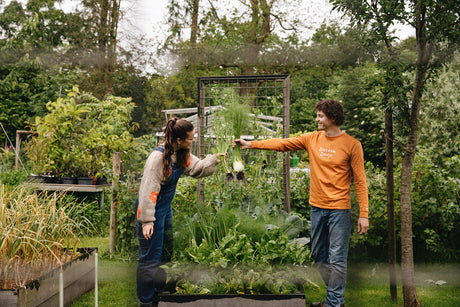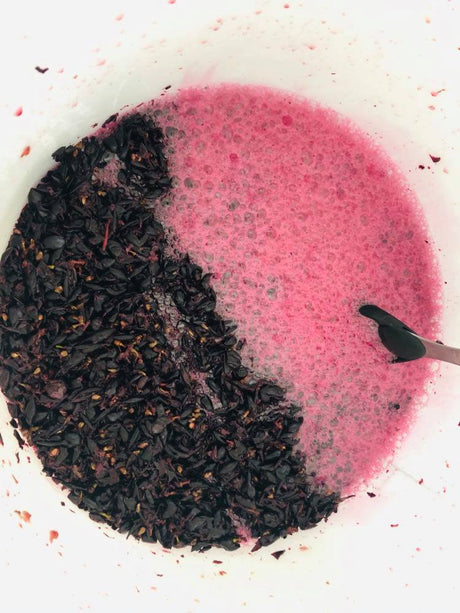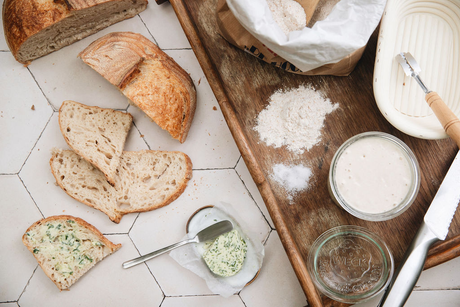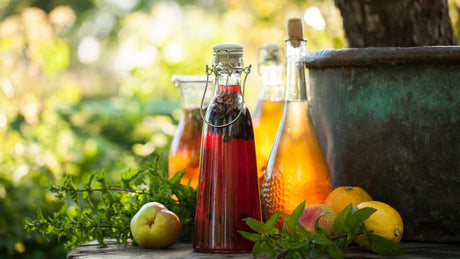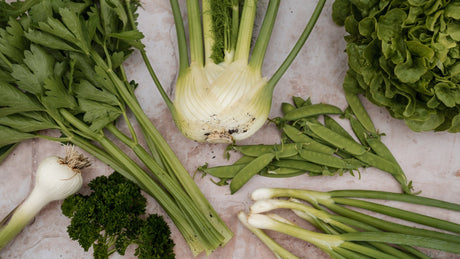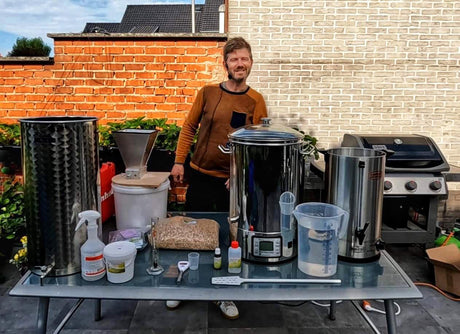Are you a true vegetable garden fanatic who can’t wait to start your growing season? Then this article is perfect for you! In this blog, I’ll dive into the pros and cons of starting your indoor vegetable garden early. I’ll discuss how to start earlier, which crops benefit from this, and how to best approach this.
For example, some crops need pollination by bees in June. But the flowers you sow in your garden to attract bees often don’t bloom until July or August. On the other hand, southern plants or crops with a long growing season, such as peppers, can provide you with fruit as early as June or July if you start early. This is very different from the normal harvest time in August. In this article I will try to outline in a simple way the needs of a plant, and how these needs change during the different phases of the growth cycle.
Growing your own vegetables - Info on Plukkers.com
On our site you will find extensive information sheets for more than 50 crops in the crop index . This contains everything you need to know about sowing depth, planting distances, good and bad neighbours, and cultivation periods. The sheets also indicate where you can start the cultivation: indoors, under glass, in a greenhouse, or outdoors.
What do vegetable garden plants need?
Before you put your first seed in the ground, it's important to know the basic needs of vegetable garden plants:
- Light: Plants need light to grow. Indoors, we often need to use grow lights to mimic natural sunlight.
- Oxygen: Plants need oxygen for their chemical processes, both in the roots and in the leaves.
- Heat: This stimulates the growth and development of the plant.
- Water: Essential for all plants to survive and grow.
- Nutrition: Plants require different nutrients depending on their growth stage.
A seed grows into a plant with the right mix of light, oxygen, heat, water and nutrients. Whether you grow indoors, outdoors or under glass, we can always control oxygen, water and nutrients. Light and heat, on the other hand, depend on the sun, which varies with the seasons. The amount of light and heat your plants receive varies with the time of year. We adapt our cultivation strategies to the amount of sunlight we get. That is why you don’t see palm trees on the Grand Place in Brussels or Amsterdam, but you do on the Plaça Reial in Barcelona. To understand how to grow well indoors, we will first take a closer look at the importance of sunlight and the growth cycle of a plant.
The Sun and the Growth Cycle of Plants
The sun is a huge star, about a million times bigger than our earth. It radiates light and heat to all the planets in our solar system. Depending on the distance to the sun and the angle at which the light enters, we need a t-shirt or a warm jacket in different seasons. We measure temperature in Celsius, but when it comes to light, things get a bit more complex.
Light has two important aspects: intensity and colour. Light intensity is measured in lumens; a candle emits few lumens, while a searchlight on a prison yard emits many lumens. Light colour is something else and is measured in Kelvin. For example, the light at the dentist is blue, while the light in a cosy brasserie is redder. These technical details are less important for your vegetable garden. What is important is that plants need different types of light color at different stages of their growth. In the growth phase they need blue light, while in the flowering phase they benefit from redder light.
The advantage of sunlight is that it contains the full spectrum of light colors. At sunrise and sunset you often see a warm, red light, while a cloudy winter day gives a bluer light. This ensures that your plants get the full spectrum of light colors they need, depending on the season and time of day, to grow healthy and mature. There are also grow lights that mimic this, and therefore produce both blue light and reddish light.
Growth of vegetable garden plants
- Conditions for seed germination
For a seed to germinate, water, warmth and light are essential.
Water: Germination begins when the seed receives sufficient water. The seed has a protective seed coat that is softened by the water, allowing the germinating plant to grow outwards.
Warmth: Water alone is not enough; warmth is needed to start the germination process. The warmth of the sun or indoors acts as a signal for the seed to start growing. Outside in the winter, many seeds will not germinate, but with the first spring sunshine they can quickly emerge and develop.
Light: Light plays an important role in photosynthesis, the process in which light is converted into glucose, the food for the young plant. In the initial phase, the plant does not need any extra nutrients, because the seed often already contains some food. Cold light with a color temperature of about 6000 to 6500 Kelvin is ideal. If there is a lack of light, seedlings will stretch in search of light.
- Young plants in the vegetable garden
Once the plants have at least two true leaves, they develop roots, stems and leaves. The sap flows start to function well.
Nutrition: A young plant only gets 20% of its nutrition from the soil, mainly nitrogen for leaf growth and to a lesser extent phosphorus for root development and flower formation. Potassium supports the metabolic processes. The largest part of the nutrition, 80%, comes from light, especially blue light (6000 to 6500 Kelvin). Without sufficient light, plants remain weak and stretched.
Water: Water is crucial for young plants, as they consist largely of water.
Oxygen: Plants need oxygen for their chemical processes. Leaves take oxygen from the air, while roots take it from the soil. Little can grow in compacted soil.
Heat: Although heat is less crucial than it is for germination, it is still important. Plants that germinate at higher temperatures, such as 28°C, will develop well at lower temperatures, such as 18°C, as long as they get enough light.
- Needs of mature vegetable garden plants
Feeding: Mature plants, especially root and leguminous crops, usually require little additional feeding. Crop rotation often leaves enough nutrients in the soil. Leafy vegetables have similar nutritional needs to young plants: mainly nitrogen, with smaller amounts of phosphorus and potassium. Fruit crops and potatoes require more phosphorus and potassium as they mature. Follow the instructions on the packaging or make your own comfrey manure for a free and nutritious supplement.
Light: For fruiting, slightly warmer light is desired, with a colour temperature of 3000 to 3500 Kelvin. Ideally, the plants are in a greenhouse or conservatory, where they receive all the necessary light colours. During fruiting, light with a temperature of 2500 to 3000 Kelvin is optimal, which the sun provides excellently.
Water: Mature plants need less frequent watering due to their deeper roots, but when growing in pots you must keep a close eye on them to ensure they get enough water.
Oxygen: The need for oxygen remains the same as that of young plants.
Heat: Each plant has an optimum growing temperature, usually above 15 degrees Celsius for fruit crops. That is why we only plant these in the greenhouse or glasshouse after mid-May to prevent frost damage, unless you can heat.

Winter pre-cultivation with aids
Now that you know what your plants need in different growth phases, you may understand that you normally can’t start growing in the winter. But with the right tools, you can still start your vegetable garden earlier. Please note: some crops, such as root vegetables, do not grow well when transplanted (I make an exception for beetroot and fennel).
In the vegetable garden it is less lucrative than in commercial growers. Although you can grow cauliflower under lights, it is quite expensive. What you can do is continue your hobby on a smaller scale during the winter. Of the three stages (germination, young plant and mature plant) described above, I grow the first two stages indoors.
Example: peppersI use a propagator to start growing peppers and other plants such as flowers, tomatoes, lettuce, beets, fennel and onions.
Germination: For germination I use a propagator, a closed growing cabinet with which you can regulate the temperature and light ( 6400 Kelvin grow lamps) . I germinate my pepper seeds at 28°C, and within 4 days the plants emerge. This goes much faster than on a windowsill. In the beginning I keep the oxygen grids in the lid closed. As soon as the plants are visible, I open the grids. The germination process is crucial for a strong plant. I start pre-germinating from the end of December; it takes a few weeks before they are ready.
Young plants: After 10 to 20 days, when the cotyledons are open, I remove the plants from the propagator. Light is now more important than heat. I keep the plants under grow lights with a color temperature of 6400 Kelvin , 15 hours a day. Don't forget the baby milk! I transplant the plants into 9 cm pots with potting soil for vegetable gardens, which contains enough food for 6 weeks. I keep the pots in a bowl of water to keep the soil moist. After six weeks, around mid-February, I transplant the plants into 15 cm pots with extra potting soil and nutrients. They remain under the lights, 15 hours a day, until the first longer days of late March or early April. Then I move them to the windowsill for a broader spectrum of light and let the flowers bloom.
Maturing: Only after mid-May do I plant the peppers in full, rich soil in the greenhouse or conservatory, where they will quickly produce fruit. In contrast to plants that grew on the windowsill and turned pale green, the plants that received a lot of light get a rich harvest. The windowsill plants had a lot of problems with flower and fruit setting and gave a smaller harvest.
When does it go wrong?
A common problem is an imbalance in growing conditions. Plants that receive too much or too little nutrition, or not enough light, will not grow optimally. Invest in good grow lights and a reliable propagator to create the right conditions for your plants. Also consider the specific needs of each plant species and adjust your growing strategy accordingly.
Finally
I hope you are now inspired to get started with your indoor vegetable garden. Start pre-cultivating in January and watch your plants grow and flourish. Don't forget to inspire your friends and acquaintances to start a vegetable garden too. Do you find this information valuable? Feel free to share it and support our site by ordering your vegetable garden supplies from us!
Happy gardening!
Tom Deseyn


